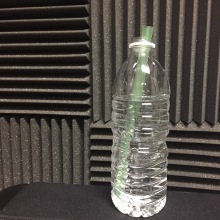Matt Edwards
Associate Professor of Voice, Shenandoah Conservatory Artistic Director of the CCM Vocal Pedagogy Institute
Mix it up Monday: Teaching flow phonation with a straw and a water bottle

 Straw phonation is all the rage right now in the vocal pedagogy world. Today I want to talk about a variation that I like to use to improve flow phonation. Dr. Ingo Titze says “Flow phonation is a term used in voice therapy and voice pedagogy to describe a production that feels effortless and efficient because ample airflow is passed through the glottis when the vocal folds vibrate.” It is the opposite of pressed phonation, where the vocal folds press together, limiting airflow, resulting in labored vocal production that will quickly lead to fatigue. Students often have a hard time telling if they are in flow or pressed phonation. This exercise helps them distinguish the two by providing a visual aid – bubbles in water.
Straw phonation is all the rage right now in the vocal pedagogy world. Today I want to talk about a variation that I like to use to improve flow phonation. Dr. Ingo Titze says “Flow phonation is a term used in voice therapy and voice pedagogy to describe a production that feels effortless and efficient because ample airflow is passed through the glottis when the vocal folds vibrate.” It is the opposite of pressed phonation, where the vocal folds press together, limiting airflow, resulting in labored vocal production that will quickly lead to fatigue. Students often have a hard time telling if they are in flow or pressed phonation. This exercise helps them distinguish the two by providing a visual aid – bubbles in water.
Grab a bubble tea straw or other wide tube (Lowe’s sells clear tubes in multiple sizes that can be cut to length). Have the student place the straw/tube in a half-full bottle of water and blow bubbles. While they are blowing air, ask them to find a depth that does not produce too much resistance but keeps the straw/tube consistently below the waterline while bubbling. Now have the student vocalize on /u/ or /o/ through the straw into the water. When the water bubbles during phonation, the student is in a state of flow phonation. When the bubbles stop or become inconsistent, they are in pressed phonation. I begin with simple 1-2-3-2-1 patterns and then expand as needed. When it is time to work repertoire, we first sing the song using the straw/water bottle combo and then repeat without while trying to maintain flow.
You can simultaneously use this exercise to help the student find a relaxed and open vocal tract. Encourage the student to feel as if the air pressure in their oral cavity and pharynx creates an air pillow that opens the throat and mouth. If they are an aural learner, ask them to focus on the mids and/or bass in the sound they hear instead of the treble. Pedagogically speaking, a constricted throat raises the formants of the singing voice leading to a brighter timbre while a relaxed throat (more open) lowers formants leading to a warmer timbre. I find this especially helpful when teaching musical theatre performers to sing Golden Age “legit” ballads.
Do you have variations of this exercise you like to use in the studio? If so, please leave a comment below. If you are not yet following the blog, please sign-up on the bottom right of this page to receive an email when there is a new post. As always, thank you for reading!
Matt




I like the idea of the bigger diameter straw. I believe when Dr. Titze first wrote about this he used a regular drinking straw asking the student to not get the straw more than an inch deep in the water. I have used this with good effect with my students. However, I am going to try the larger diameter straw because I think that will make it much easier for the student to regulate the pressure.
LikeLike
This is an excellent way to attain flow phonation. I’ve used the straw with quite a few students, with good results. If the habit of constricting airflow in the throat is well established, however, the straw will not necessarily help. That’s the case with one of my students, who has had a v. f. paresis (now resolved). This week, we’ll use bubbles!
LikeLike
Cup bubbles are one of my favorite things to use in general, but especially as a therapeutic tool when a student is vocally compromised…anything causing excess tension or inflammation. I became a HUGE fan when recovering from my own vocal surgery and have kept this exercise a steady part of my vocal hygiene routine ever since. I like to do it for 2-5 mins in the morning and again in the evening. Preferring single held notes and descending slides (especially slides that begin in the upper register and land in the middle or low register). I find that it becomes very useful as a warmup tool for the speaking voice, as well, and away from any repertoire. Students who walk in feeling tired and with a heavy sounding “morning voice”…we begin with a few minutes of this and the release of tension is always audible in their speaking voice which creates a wonderful transition into singing. Also, I have found I prefer to use a stainless steel straw for this, believe it or not. The more rigid the straw, the better, in my experience. I’d love to know if anyone else has found this to be true. I have theories as to why, but would love to actually experiment with it and see if there is added benefit with the rigid straw.
LikeLike
Matt, using a water bottle as an extension to ‘straw work’ is an excellent suggestion. Thank for sharing! In response to some of the comments above, I use three different size dimensions of straw. The wider the dimension, the easier the activity. Ultimately, I want to work my students and rehabilitation clients down to a cocktail straw diameter (2.5mm), but I never start there because it is too difficult to achieve the flow phonation that you have outlined above. Typically, I start with a drinking straw (5mm) and occasionally I revert to a larger size (1cm) for the client whose voice wants to habitually ‘lock-up.’
Christie, I am interested in your ‘rigid straw’ concept. I cannot speak to the benefits, but I do wonder whether this might reduce the application of the activity for students between consults. That is, stainless steel straws are difficult to come by when compared to the easily accessible plastic straws one might find at their local grocers. I wonder whether the benefit of access might outweigh any additional benefit that the rigid straw would provide. Not a criticism…just my thoughts.
One side benefit I foresee when applying Matt’s extension is not having to deal with the spittle that accumulates at the end of the straw (without the water bottle). With full acknowledgement of my patheticness, I have to fight my gag reflex when I see spittle forming at the end of the student’s straw. Actually, I’m fighting my tendency to gag even now as I think about it! (www.djarts.com.au)
LikeLike
Hi, Daniel. You’re right that the stainless straws may be less accessible. My students will use whatever straw is available (we prefer Starbucks size and IKEA size for this exercise). I do, however, gift my long-term students with a stainless straw during the holidays or for graduation gifts. I purchase them in packages of 8 for about $5. They come with a bend in them, which is perfect for use with the water bottle. They can be washed in a dishwasher or just rinsed in the sink. They all love them!
LikeLike
Christie…you’re a very generous teacher! Love it! Where do you purchase the stainless steel straws? (https://www.djarts.com.au)
LikeLike
I look for them to go on sale throughout the year and typically find good deals on Amazon or Reuseit.com. (I’m not THAT generous…I purchase a package and then open it up and just gift them one straw each😊 It costs me less than $1 for a student and they seem to never forget to bring them when they are stainless!)
LikeLike
I guess another consideration around ‘reusing’ the stainless steel straws is the matter of hygiene. Do you find that they become a bit ‘crusty’ over time with regular use? I’m guessing that you regularly clean them 😉
LikeLike
Not at all. I pop mine in the dishwasher every couple of days, or just rinse it out. The key is to let it dry in between. I’ve had some students just leave it in their water for long periods of time. Seems to get a little gross that way. If that happens, I recommend rinsing with a little vinegar and then follow with water. They’re really quite easy to keep clean (unless you start using them to drink smoothies in between).
LikeLike
Love this- Assigning it to all my college students this week! Can’t wait to share outcomes.
LikeLike
…smoothies…there goes my gag reflex again!
LikeLike
Thanks for sharing this great technique! I use it often with many of my voice patients. I know this technique as Lax Vox. Here is the link to their website if you’re interested: http://www.laxvox.com/eng/index.html
(I have no affiliation with the company).
LikeLike
I have been doing this for 25 years now and have tried many variations. You can get a piece of tubeing from Home Depot and cut them. It is especially good because they bend and better for posture also it is wider and if someone has swelling it is really helpful. The amount of water and size of the bottlle all matter.
LikeLike
I just looked at Megan’s . LGo to Home Depot buy a long piece and it is super cheap!!!!! You can make a bunch of them for your students! IT is the same thing
LikeLike
I continue to use the straw method, and heartened by further research and teaching strategies. Keep posting
LikeLike
I love this concept. Can you post a demonstration video at some point?
LikeLike
Pingback: Mix it up Monday: A three step approach for strengthening head-mix in females | Matthew Edwards
you have a excellent weblog here! do you need to cook some invite posts in my blog?
LikeLike
Pingback: Mix it up Monday: Balancing breath and tone with lip trills | Matthew Edwards
Pingback: Mix it up Monday: Richard Miller’s thoughts on addressing a shaky jaw | Matthew Edwards
Matt,
I want to use this in my studio, but I am a bit confused. Is the goal to create big bubbles and keep them consistent or small ones? A student of mine (14 y/o) and I tried your exercise together, and we felt like it was somewhat easy to keep the bubbles consistent throughout a pentatonic scale. I felt like it was too easy — maybe we are doing something wrong?
LikeLike
Pingback: Mix it up Monday: How to allow placement to reveal itself (pt. 1) | Matt Edwards
Pingback: Mix it up Monday: How to allow placement to reveal itself (pt. 2) | Matt Edwards